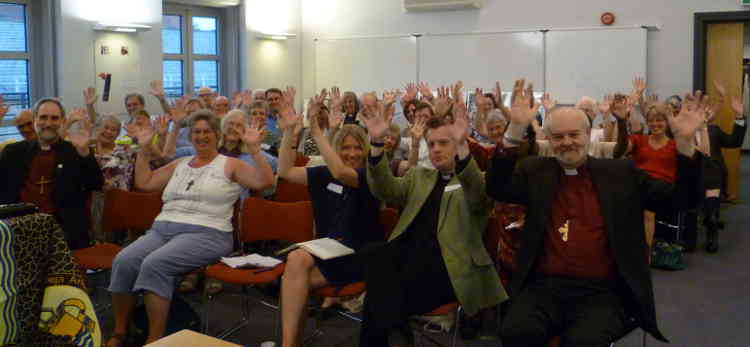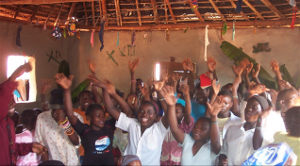
The Meeting. Bishop Mark Van Koevering is at the left, and Bishop Richard Chartres, Bishop of London, at the right.
Bishop Mark excited and inspired us whilst telling of all that is going on in the church in Niassa. He said that in Africa relationship is very important and it is very powerful. In Niassa they operate from a strong and overlapping relationship between Worship, Ministry and Mission of which God and the church is at the centre. They were dealing with a number of situations:
-

‘Celebrating being partners in what God’s doing’
(One of Bishop Mark’s pictures for the talk, taken in Nzinje in Lichinga)
- They also realised that Conversion is not the same as discipleship and so congregations would initially just meet, sing a few hymns and do the ‘Rooted in Jesus’ course before any formal liturgy was introduced. The women are the backbone of the church as many of the men had fled or died in the wars and half the population is under twelve years of age.
- Then there was the need for Sustainability. Mozambique was the third worst on the World Development Index but now is the sixth worst not only economically but also with respect to leadership. Sixty percent of the population goes hungry for part of the year and this has resulted in stunted children, physically and mentally. Also due to the history of the Anglican Church in Mozambique many of the churches are at the ‘end of a goat track’ i.e. way beyond the end of made roads, as they were only permitted to work with one people group. Since independence they are now free of that restriction.
- Need for Integrated Mission Policy - such as the i) ‘Salt, Light and Health Project’ along the shore of Lake Niassa. This has six employees, many, many volunteers and has greatly improved the health of 30,000 people in that area. ii) Before the ‘Equipa da Vida’ (Life Teams), there had been no drugs or testing for HIV/Aids and now there are 200 volunteers working with 400,000 people in their communities in the areas of HIV/Aids support, health, and agriculture. iii) Now there are some ‘Diocesan Schools’.
Challenges
- There was 65% illiteracy, 47% are undernourished, 54% are in absolute poverty and the life expectancy is 47.
- Also there is rapid urbanisation and the problems of modernity such as horrific changes in rural life to modern life bringing lack of rootedness, people living alone in cities, and once people have experienced having electricity they don’t want to go back to the rural areas.
- For Bishop Mark the area he needs to cover is 1.5 times the size of UK, is remote, and travel is costly travelling on unmade roads. He spends 150 days on the road, in two week stints, just to see his priests once a year.
- Niassa is the only diocese in Southern Africa that has a Muslim majority. (95% of the Muslims are in Niassa).
- Need for Multiplication into three Dioceses: to do this they needed to be viable in terms of leadership and finance so they started to look at stewardship in its broad sense using the concept of GRACE, and saw that it involved
G-enerosity
R-econciliation
A-ction
C-ompassion
E-ncouragement
This gave a powerful vision, giving hope for the poor. It was life renewing, space creating for leaders exercising ministries, and it gave room for demonstration of the power and glory of the Gospel thereby joining in with what God is doing.

